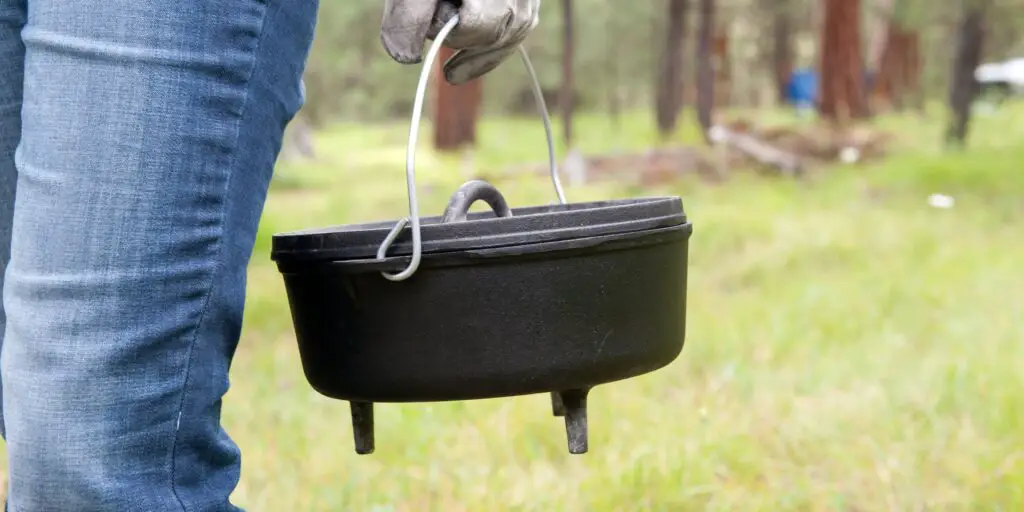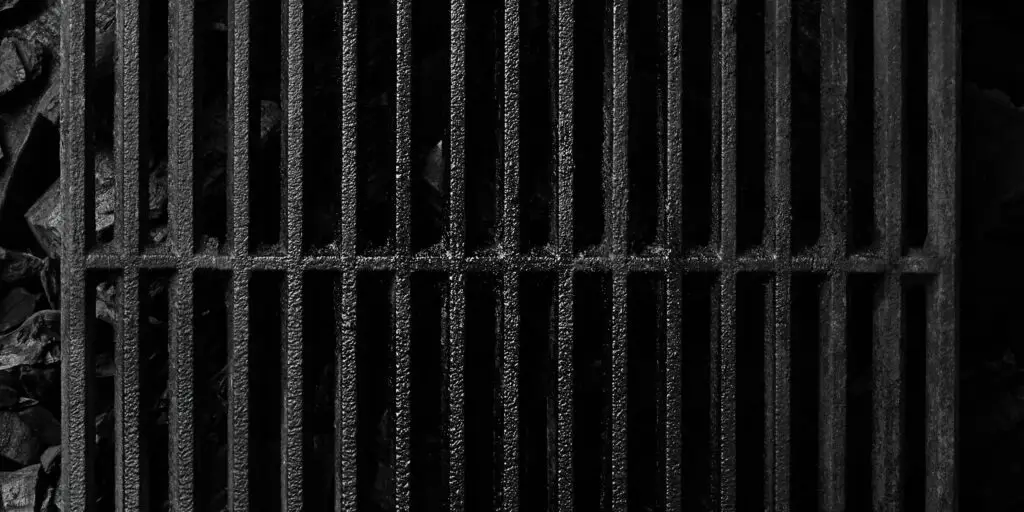Imagine yourself amid the great outdoors, surrounded by the awe-inspiring beauty of nature and the irresistible scent of sizzling food wafting through the air. It’s an enchanting experience that fills the hearts of every camper with warmth and joy.
Whether on an exhilarating camping trip with your closest friends and family, hosting a lively backyard barbecue, or venturing into the wild for thrilling adventures, one steadfast companion never fails you: outdoor cast iron cooking.
With its unmatched durability, exceptional heat retention, and incredible versatility, cast iron cookware is the perfect partner for outdoor culinary escapades. Not to mention, its natural nonstick properties make cooking and cleaning up a breeze.
Once you’ve experienced the mouthwatering results that cast iron delivers, there’s no turning back. So, let’s explore why seasoned campfire chefs and outdoor enthusiasts prefer cast iron as their ultimate choice for outdoor cooking.
Why Cast Iron is the Preferred Choice for Outdoor Cooking
Cast iron cookware is in a league of its own regarding outdoor cooking. Its robust and unyielding nature allows it to easily tackle any grilling or campfire challenge, withstanding intense heat without warping or melting unlike other types of cookware.
This exceptional durability makes cast iron the go-to choice for adventurous outdoor enthusiasts who value reliability. But that’s not all—cast iron’s heat retention and distribution capabilities are equally impressive.
Once heated, it holds onto that heat, ensuring your steaks are perfectly seared, and your stews are infused with mouthwatering flavors. The consistent and efficient heat distribution of cast iron cookware gives you precise control over your cooking, guaranteeing exceptional results every time.
And even if your cast iron cookware shows wear and tear, fear not! You can easily revive it to its former glory with tender, loving care. By cleaning and re-seasoning it, you’re investing in a culinary companion that will serve you for years.
What Types of Cast Iron Cookware Can You Use for Camping?
Honestly, you can use pretty much any type of cast iron cookware for outdoor cooking. But if you want to pack as few things as possible for your camping trip, you can boil them down to the following versatile pieces of cast iron cookware:
Skillet

The classis cast iron skillet is arguably the most versatile piece of cookware you can bring along to your adventure. This cookware can handle everything from frying crispy bacon to sautéing fresh vegetables.
Whether cooking over a campfire or using a camp stove, the cast iron skillet effortlessly adapts to your outdoor cooking needs, accommodating any ingredients you toss in.
Camp Dutch Oven

The camp Dutch Oven is the ultimate heavy-duty pot for slow and steady cooking. Its sturdy construction and tight-fitting lid make it amenable for slow-cooking, making it perfect for creating mouthwatering stews, roasts, and casseroles that will leave everyone craving more.
Its innovative flanged lid design sets the camp Dutch Oven apart from other cookware. This unique feature allows you to stack hot coals on the lid, providing consistent heat from all directions. You can achieve tender, flavorful, and perfectly cooked dishes with the camp Dutch Oven.
Grill grates

Enhance your outdoor cooking experience with the elegance of cast iron grill grates. These specially designed ridged grates are game-changers, creating those coveted grill marks on your meats, vegetables, and fish.
While most camping spots provide visitors with grill grates, it still pays to bring your own as previous guests may not be considerate at all when using the grates. Moreover, the grates may not be cleaned and well-maintained by the management.
Reversible griddle/grill

The reversible griddle/grill is the ultimate multitasker for your camping adventures. You have a smooth griddle for pancakes, eggs, and bacon on one side. Flip over, and you’ll find grill ridges ideal for burgers, steaks, and charred veggies. This piece is great for the breakfast rush as it can fry a large batch of food in one go.
Other Essential Items for Camp Cast Iron Cooking
Regarding camp cast iron cooking, some must-have items can seriously level up your cooking game and make cleaning easier. Check out these essentials:
For cooking:
Campfire tripod
Get a sturdy tripod to hang that cast iron cookware over the fire. It’s adjustable and provides a solid cooking surface.
Heat resistant gloves
Keep your hands safe from the sizzle of the campfire and the scorching cast iron with some heat-resistant gloves. No more burnt fingers!
Fire tongs or pokers
These tools are perfect for taming the fire, moving those flaming logs, and adjusting your cast iron cookware.
Food handling tools
Long-handled spatulas, tongs, and forks made for campfire cooking are necessary. They make flipping, stirring, and serving easier.
Aluminum foil
Aluminum foil is a lifesaver for cooking delicate or messy foods. You can also use this as a makeshift lid for your skillet to lock in your meat’s juice.
Lid lifter
A lid lifter should be a necessity if you use a camp Dutch Oven. It lets you snatch that lid safely without burning your fingers.
Oil
Apart from its obvious necessity for cooking, oil is essential for cleaning and maintaining your cast iron cookware later on. Go for oils with a high smoke point, like vegetable or canola oil.
For cleaning:
Pot scraper
Get a nifty pot scraper to tackle those stubborn food bits stuck to your cast iron. It completely changes how you maintain your pots and pans.
Chainmail
No, we’re not talking about medieval armor. A chainmail scrubber or mesh is gentle yet effective for cleaning cast iron. Wave goodbye to scratches and hello to spotless cookware.
Paper towels
Keep a roll of paper towels nearby for wiping and drying your cast iron after cleaning. They’re super absorbent and disposable, making cleanup simple.
How To Cook With Cast Iron Over an Open Fire
Cooking with cast iron over an open fire can be a delightful and rewarding experience. It allows you to enjoy the great outdoors while still creating delicious meals. Here are some tips to help you cook with cast iron over an open fire:
Cook with embers, not flames
When cooking over a fire, it’s best to focus on the glowing embers instead of the flames. These embers provide consistent, even heat for your cast iron cookware. Allow the fire to die down until you have a bed of hot embers, ensuring optimal cooking conditions for your delicious meals.
Preheating is still key
As with indoor cooking, preheating the pan and the oil is a reliable safeguard against food sticking to the pan. This allows the Maillard reaction to do its thing right when the food comes into contact with the pan. If you add food to a cold pan, it allows its natural proteins to form bonds with the metal below, hence causing it to stick.
Skip the “skillet rotation” trick
No need for constant skillet rotation when cooking over a campfire. Unlike the gas stove, where rotating the skillet is often necessary to distribute heat, cooking over an open flame offers a natural advantage:you can effortlessly achieve a delightful and even heat distribution by spreading the coals around. The coals act as perfect heat conductors, ensuring your meals cook uniformly, leaving no spot unattended.
Keep flare-ups under control
Minimizing the drippings, especially on cast iron grates, is important to prevent pesky flare-ups caused by fats or oils dripping into the fire. Trim excess fat from your meat and sear it before moving it to a cooler part of the fire.
This technique keeps flare-ups at bay and creates a more controlled cooking experience. It’s all about reducing the amount of fat dripping into the flames, lowering the risk of sudden bursts of fire. With fewer flare-ups, you can focus on cooking your food peacefully and savor flavors without unwelcome surprises.
Put coals on top of Dutch Oven lids
Place some hot coals on the lid to maximize your Dutch Oven cooking. This method ensures an even heat distribution, allowing your food to cook thoroughly from top to bottom. The hot coals are an additional heat source, essentially mimicking the function of – you guessed it – a traditional convection oven.
How to Clean Your Cast Iron Cookware While Camping
You’re camping and cooking up a storm with your cast iron cookware. Now comes the dreaded part: cleaning it up. Don’t worry; we’ve got you covered with some laid-back tips on how to clean your cast iron while camping:
Put water in the pan while over the fire
Pour some water into the pan while your cast iron is still warm from cooking. Here’s the trick: put it back on the fire or grill grate to get that water nice and hot. It will help loosen up any stubborn food bits sticking to the surface.
Scrub the pan with chainmail using tongs
Grab a chainmail scrubber and hold it with your tongs. Then, thoroughly scrub the pan’s interior. Let the chainmail’s texture work its magic, loosening up any stubborn bits without causing any harm to the seasoned surface.
Pour out the water and dry the pan
Once you’ve given your pan a thorough scrub, pour out the water. Make sure you get rid of all the food remnants. Grab a clean towel and wipe away any visible moist spots. From there, you can put the pan on the fire until it dries completely.
Oil the pan before storing
Get some oiling done to keep your cast iron in good condition. While the pan is still warm, grab a paper towel or cloth and apply a thin layer of oil. It will protect it from rust and maintain that glorious seasoning until your next camping trip.
Your Outdoor Cooking Companion
When you’re out camping, cast iron cookware becomes your reliable companion for outdoor cooking. Its durability, excellent heat retention, and versatility can make it your go-to cookware choice.
Whether you need a skillet for frying, a camp Dutch oven for slow cooking, grill grates for a barbecue, or a reversible griddle/grill for diverse meals, cast iron has got you covered.
To enhance your cooking experience, bring essential items like a campfire tripod, heat-resistant gloves, fire tongs, food handling tools, aluminum foil, a lid lifter, and oil.
When cleaning your cast iron while camping, simply heat water in the pan, use chainmail scrubbing with tongs to remove residue, dry the pan thoroughly, and apply a thin layer of oil for protection.
With these tips and your cast iron cookware, you can enjoy delicious meals in the great outdoors. Read more of our blog at the Cult of Cast Iron today and experience the joys of cooking with this amazing material! Happy cooking!

Miguel is a cast iron enthusiast from Cavite, Philippines. He works in the digital marketing field as a content marketing strategist. On the side, he manages a small online bookstore and tends to his plants.

